Physical Address
304 North Cardinal St.
Dorchester Center, MA 02124
Physical Address
304 North Cardinal St.
Dorchester Center, MA 02124
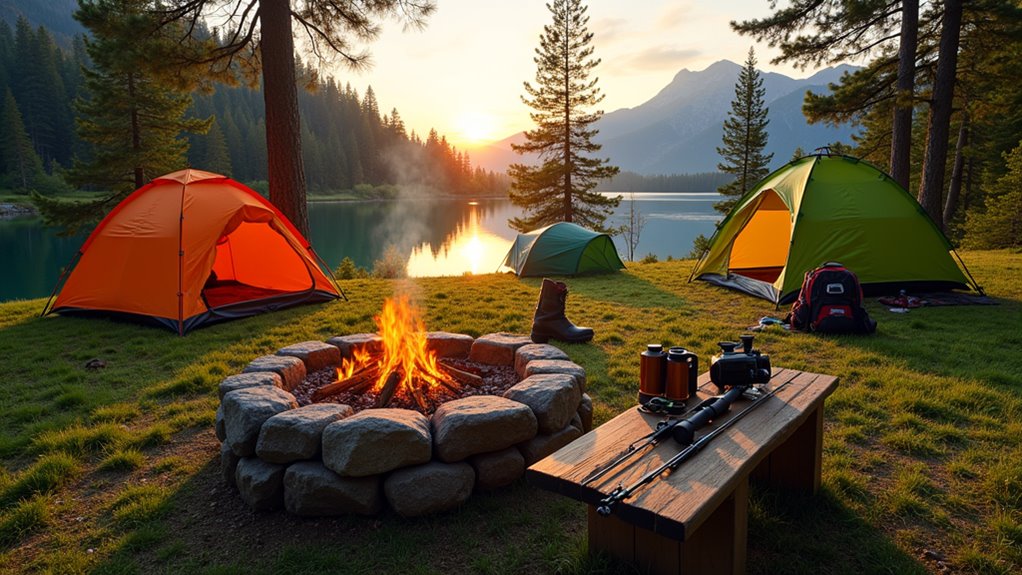
Make your camping adventure extraordinary with these 15 creative activities that go far beyond typical tent pitching and marshmallow roasting.
Like Robinson Crusoe discovering endless possibilities on his island, you’ll find that camping offers far more than just pitching a tent and roasting marshmallows. Whether you’re planning your first outdoor adventure or you’re a seasoned camper looking to shake things up, there’s a whole world of creative activities waiting beyond the typical campfire routine. The key isn’t just knowing what to do—it’s knowing which activities will transform your trip from ordinary to unforgettable.
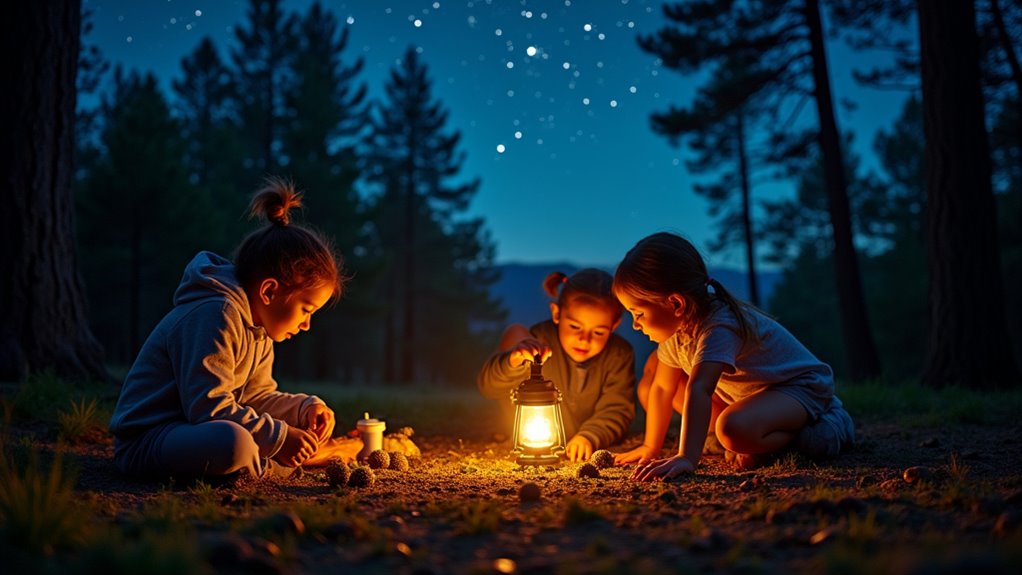
When darkness falls and the campfire begins to die down, you can transform your campsite into an exciting adventure zone with a nighttime scavenger hunt. Create a list of items that glow, reflect light, or make distinct sounds in the dark. Include things like smooth river rocks, pinecones, specific leaves, or items that crinkle when touched.
Give each participant a flashlight and set clear boundaries around your campsite for safety. Hide glow sticks, reflective tape pieces, or battery-operated tea lights as bonus treasures. You’ll want to prepare the hunt area while there’s still daylight, marking any potential hazards.
Make it collaborative rather than competitive – everyone works together to find all items. This keeps the mood fun and prevents anyone from wandering too far into unfamiliar territory alone. Once everyone returns from the hunt, gather around the fire again and play some campfire games to wind down the evening with storytelling and laughter.
While your campsite offers the perfect outdoor studio, you can turn fallen leaves, smooth stones, and clay-rich soil into stunning artwork that celebrates your natural surroundings. Start by collecting interesting materials like pinecones, twigs, colorful leaves, and smooth rocks.
Transform your campsite into an artist’s paradise using nature’s palette of leaves, stones, and earth as creative materials.
Create natural paintbrushes from sturdy sticks and soft moss or feathers.
Make your own pigments by crushing berries, mixing clay with water, or grinding charcoal from your fire pit. Flat rocks become perfect canvases for painting, while larger stones can transform into sculptural pieces.
Try arranging leaves and flowers into temporary mandalas, or press plants between heavy rocks to preserve them.
Document your creations with photos before leaving them as gifts for nature, ensuring you follow Leave No Trace principles. After a day of creative expression, you’ll appreciate having a comfortable sleeping pad to rest on while admiring your temporary outdoor gallery under the stars.
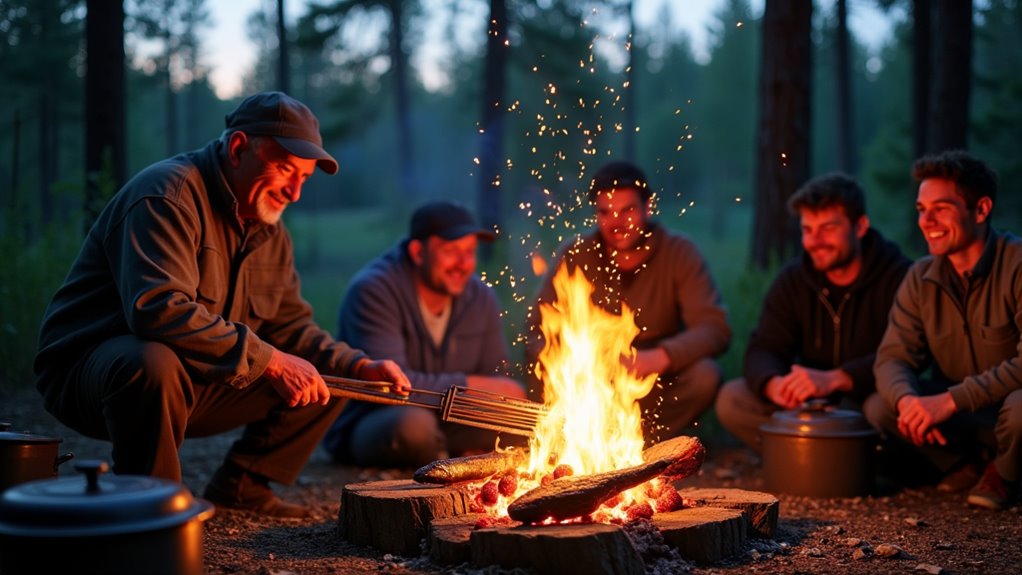
Transform your next camping trip into a culinary adventure by challenging yourself to cook exclusively with ingredients you can forage, catch, or source locally. Start by researching edible plants native to your camping area—wild garlic, dandelion greens, and berries are excellent beginner options. Pack basic seasonings like salt and pepper, but let nature provide the main ingredients.
Try fishing for fresh trout, then stuff it with foraged herbs and wrap it in large leaves before burying it in hot coals. Create a simple soup using wild mushrooms, edible flowers, and stream water. Make tea from pine needles or mint you’ve found along trails.
Always bring a field guide to identify safe plants, and never eat anything you can’t positively identify. This challenge sharpens survival skills while creating memorable meals. If you’re camping near a lake or river, consider whether renting a boat might give you access to better fishing spots for your culinary adventures.
After satisfying your taste buds with foraged delicacies, you can wind down your camping day with an unforgettable outdoor cinema experience. You’ll need a portable projector, white sheet or camping screen, and a power source like a portable battery pack. String your makeshift screen between two trees or use your RV’s side as a backdrop.
Choose movies everyone’ll enjoy – comedies work great for group dynamics. Download films beforehand since you likely won’t have reliable internet. Set up camp chairs in a semicircle, grab blankets for warmth, and prepare popcorn over your campfire.
Start after sunset for ideal viewing. The combination of starlit skies, crackling fire sounds, and your favorite films creates camping magic that beats any indoor theater experience. You can find cheap camping gear like portable projectors and battery packs through various budget-friendly resources that help keep your outdoor movie night affordable.
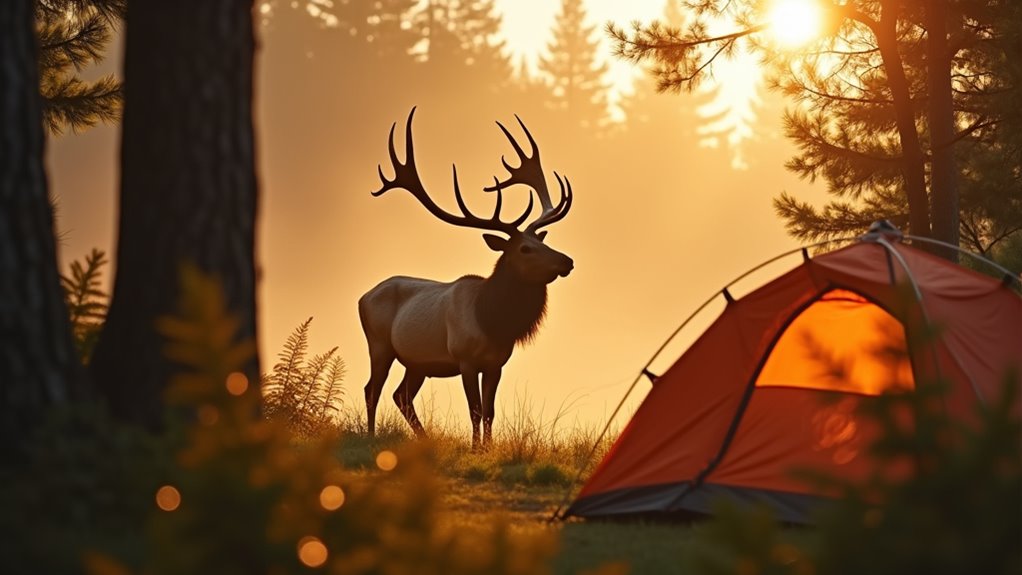
Once morning light filters through the trees, you’ll discover your campsite has transformed into a natural wildlife studio teeming with photographic opportunities.
Grab your camera or smartphone and start exploring the immediate area around your tent. Look for birds perched on branches, squirrels gathering nuts, or insects on wildflowers. Move slowly and quietly to avoid startling your subjects.
Focus on capturing different perspectives – get low for ground-level shots of small creatures or look up for birds in the canopy. Even without expensive equipment, you can create compelling images by paying attention to lighting and composition.
Early morning and late afternoon offer the best natural lighting conditions.
Document tracks, nests, and habitats too. You’ll return home with a unique visual diary of your camping adventure.
As you venture further from your campsite for that perfect shot, remember basic navigation techniques to ensure you can easily find your way back to your tent.
While you’re exploring the wilderness with your camera in hand, you can add an element of treasure hunting to your outdoor adventure through geocaching. This modern-day treasure hunt uses GPS coordinates to guide you to hidden containers called geocaches.
Download a geocaching app like Geocaching.com or c:geo, then search for caches near your campsite.
You’ll find waterproof containers ranging from tiny magnetic cases to ammo boxes, each containing a logbook and sometimes small trinkets. When you discover a cache, sign the logbook and trade items if you’d like.
The hunt takes you off beaten paths to scenic spots you might otherwise miss.
Geocaching combines hiking, problem-solving, and discovery while encouraging you to explore your camping area more thoroughly than typical sightseeing allows.
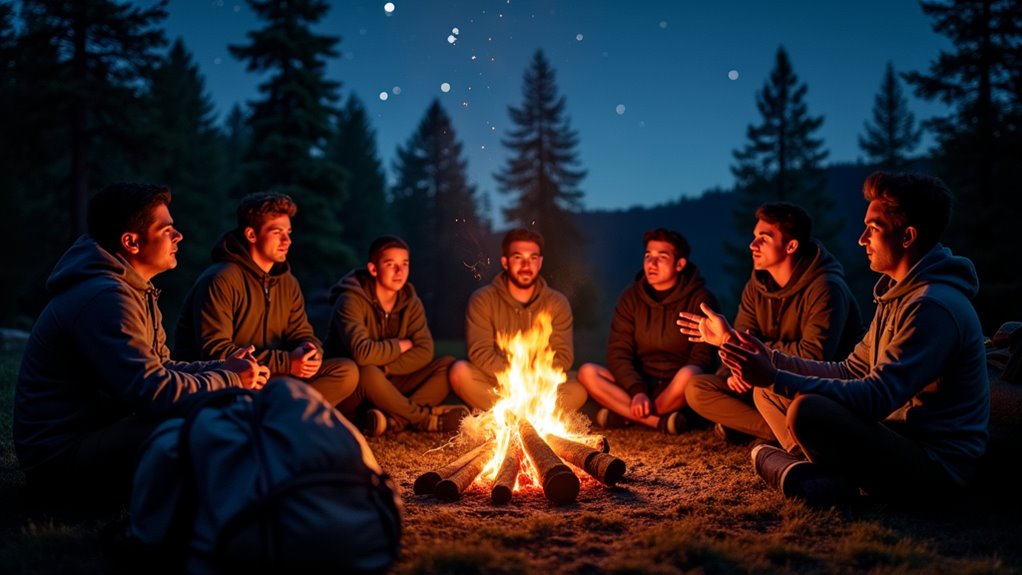
As darkness settles over your campsite, gather everyone around the flickering campfire for an evening of storytelling that’ll create lasting memories. There’s something magical about sharing tales under the stars that brings people together like nothing else.
Here are four ways to make your storytelling sessions unforgettable:
Remember that the best campfire stories often come from personal experiences and should be tailored to your audience’s age and comfort level with scary content.
When you’re ready to get everyone’s blood pumping and add some friendly competition to your camping trip, classic outdoor games like capture the flag transform your campsite into an action-packed playground. Divide your group into two teams and establish clear boundaries using natural landmarks like trees or rocks.
Each team needs a distinct flag—bandanas, t-shirts, or towels work perfectly. Place flags in opposite base areas that are easily defendable but not impossible to reach.
Explain the rules clearly: capture the opposing team’s flag and return it to your base without getting tagged. Tagged players must freeze until teammates free them. Set time limits to keep games moving, and rotate teams to mix up the dynamics.
Other classics like hide-and-seek, tag variations, and relay races work equally well for building camaraderie. To make your camping adventures more affordable, consider utilizing share economy platforms that can help you access camping gear and equipment without the high upfront costs of purchasing everything new.
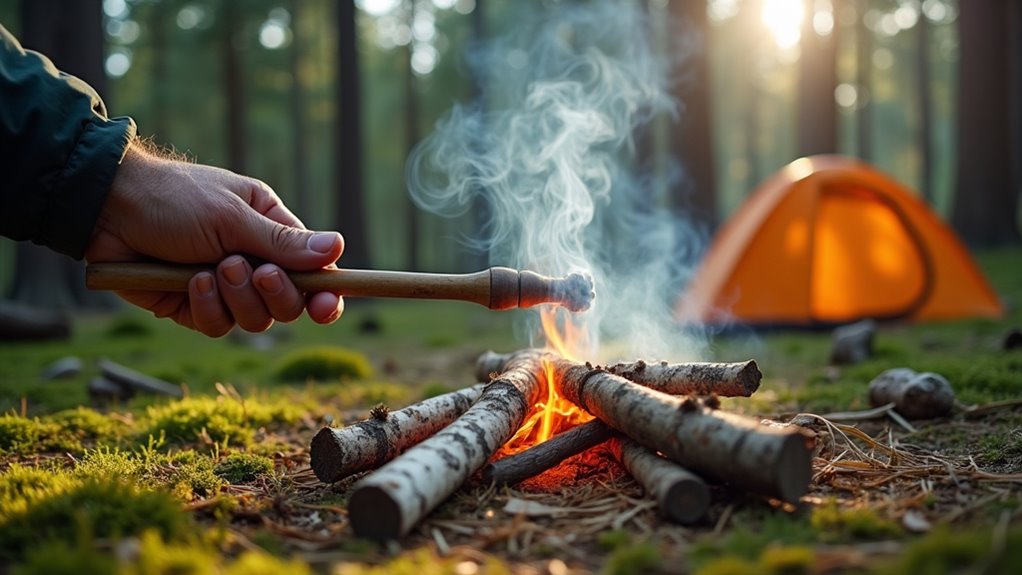
Since camping already puts you in nature’s classroom, it’s the perfect time to develop practical wilderness skills that’ll boost your confidence outdoors. These hands-on activities combine education with entertainment, making learning feel like play.
Start with these essential skills:
You’ll develop problem-solving skills while gaining valuable knowledge that could prove vital in emergencies. While these natural shelters are great for skill-building, remember that proper camping shelters are essential for reliable protection against harsh weather conditions.
While most campers sleep through nature’s daily symphony, you’ll discover an entirely different wilderness by setting your alarm for dawn. Birds are most active during the first two hours after sunrise, making this prime time for observation and recording.
Pack lightweight binoculars and a smartphone with a recording app. Position yourself near water sources or forest edges where bird activity peaks. Stay still and quiet—movement scares wildlife away.
Record different calls to identify species later using apps like Merlin Bird ID.
Create a simple log noting time, weather, and species spotted. You’ll be amazed how many different birds share your campsite. This peaceful activity connects you deeper with nature while building knowledge you’ll use on future trips. Fall’s crisp morning air and changing leaves create the perfect backdrop for this early morning adventure, making your fall camping trip even more memorable.
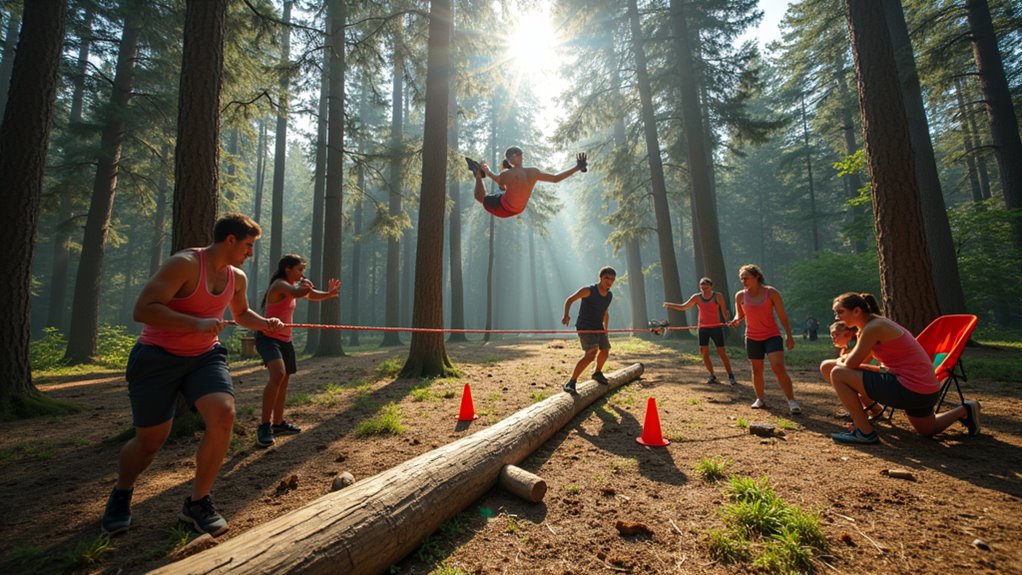
After you’ve explored nature’s quieter side, it’s time to amp up the energy with some friendly competition that’ll get everyone moving. A camping olympics transforms your campsite into an arena of laughter and excitement, perfect for groups of all ages.
Transform your peaceful campsite into a high-energy arena where friendly competition brings everyone together through laughter and movement.
Set up stations around your camping area and rotate teams through different challenges. Keep score on a notepad and award prizes using camp supplies or nature items like pinecones.
Here are four engaging olympic events to try:
For those who enjoy camping while cycling, these physical challenges provide an excellent way to stretch your legs and engage different muscle groups after long days in the saddle.
Once the campfire dies down and darkness blankets your campsite, you’ll discover one of camping’s most magical experiences waiting overhead. Away from city lights, the night sky reveals thousands of stars you’ve never seen before.
Download a stargazing app like SkyView or Star Walk before your trip. These apps identify constellations when you point your phone skyward. Start with easy-to-spot patterns like the Big Dipper, Orion’s Belt, or Cassiopeia.
Bring red flashlights to preserve your night vision while reading star charts. Lay back on sleeping bags and let your eyes adjust for twenty minutes – you’ll see dramatically more stars.
Create constellation stories with kids or challenge friends to find specific star patterns. You’ll leave with newfound appreciation for the universe’s vastness.
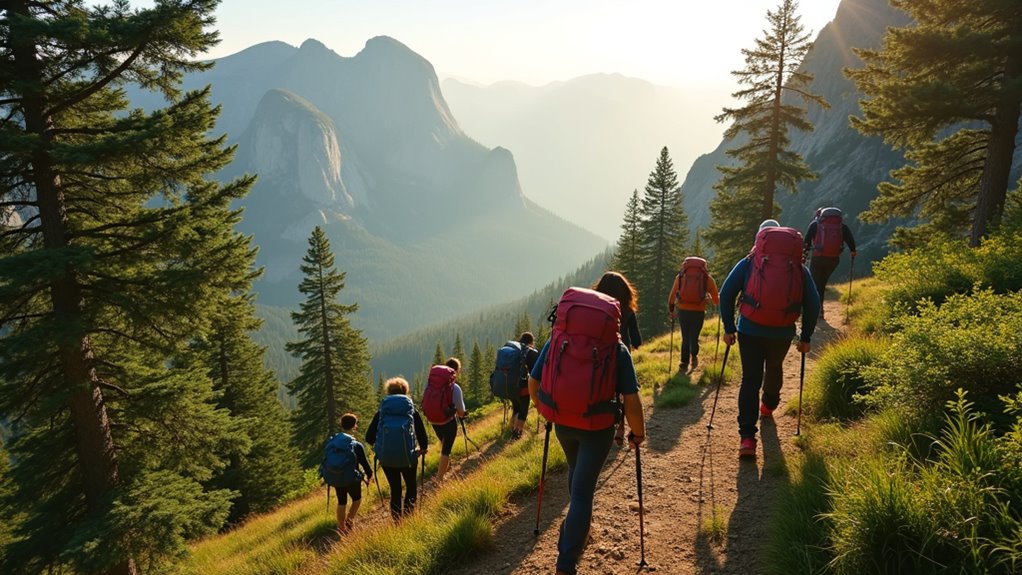
When morning light filters through the trees, gather your group for one of camping’s most rewarding activities: exploring the trails that wind through your area’s hidden gems. You’ll discover breathtaking viewpoints, hidden waterfalls, and wildlife habitats that most visitors never see.
Before setting out, establish these essentials:
Research local trail maps beforehand and check weather conditions. Consider purchasing travel insurance to protect against unexpected injuries or emergency evacuations during remote hiking adventures. You’ll create lasting memories while strengthening group bonds through shared adventure.
Why not slow down and capture the beauty around your campsite through art and observation? Outdoor sketching and nature journaling don’t require artistic expertise—just curiosity and basic supplies like pencils, pens, and a sturdy notebook.
Start by sketching simple subjects: interesting rocks, tree bark textures, or wildflowers. Don’t worry about perfection; focus on really seeing what’s in front of you. Add written observations about colors, sounds, and weather conditions. Note bird behaviors, insect activity, or how light changes throughout the day.
This activity works perfectly during quiet morning hours or lazy afternoons. You’ll develop a deeper connection with nature while creating a personal keepsake of your camping experience. Kids especially love drawing their discoveries, making this an excellent family activity.
If you’re traveling in an RV, consider sketching your campsite setup and surrounding views as part of your winter storage preparation memories before the camping season ends.
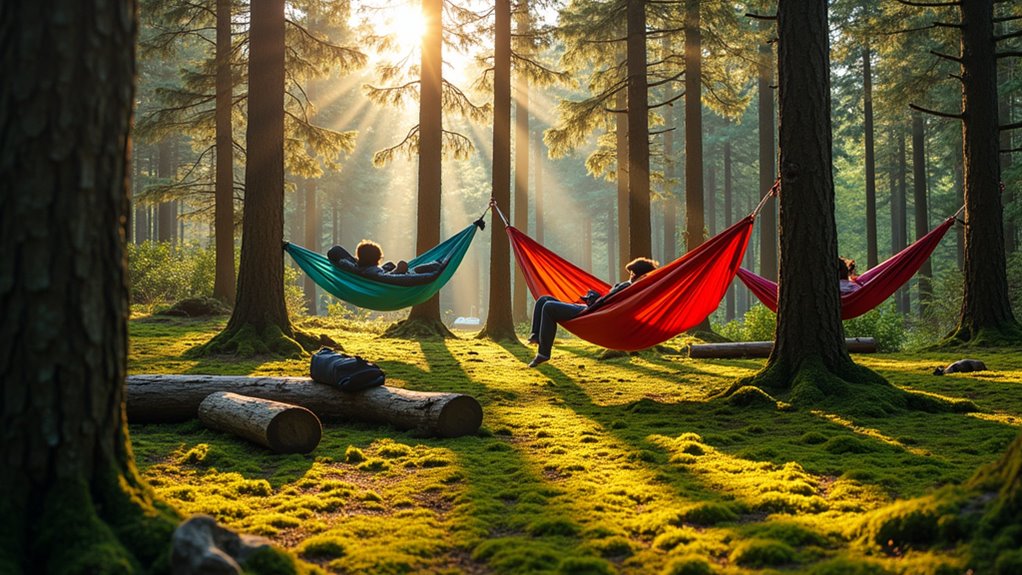
After spending time actively observing and sketching the natural world, you’ll want to create the perfect spot for complete relaxation. Setting up hammock relaxation zones transforms your campsite into a tranquil retreat where you can unwind completely.
Choose sturdy trees spaced 12-15 feet apart and hang your hammock at a gentle curve—not too tight or too loose. You’ll sleep better and feel more comfortable with proper setup.
Here’s what makes the ultimate hammock zone:
Hammocks make excellent camping companions because they’re lightweight, versatile, and provide both comfortable seating during the day and a cozy sleeping option at night.
You’ll discover this becomes your favorite campsite sanctuary.
You’ll discover that camping offers endless possibilities beyond pitching a tent and roasting marshmallows. With these activities, you’re transforming your outdoor experience into an adventure-packed getaway that’ll create lasting memories. Research shows that spending just two hours in nature weekly can markedly boost your well-being and reduce stress levels. So grab your gear, gather your crew, and start planning activities that’ll make your next camping trip absolutely unforgettable. Nature’s waiting for you!